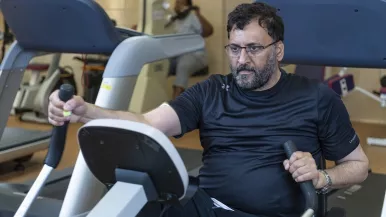We know that exercise is good for our hearts and overall health. But is that true for people living with heart failure? And if it is, how should they start exercising?
The good news is that exercise is safe for heart failure patients even at fairly high risk, and it has health benefits. But there are some guidelines they should follow to stay safe and get the best results.
Melissa Tracy, MD, a cardiologist and cardiac rehabilitation specialist at Rush, helps many patients with heart failure learn to exercise safely and improve their health.
Tracy has some advice if you have heart failure, also called congestive heart failure, and want to add exercise to your routine.
Can you exercise with heart failure?
Many people who have heart failure ask if it’s helpful — or even safe — to exercise. The short answer is yes.
Not only is it safe to exercise under medical supervision, but it has health benefits for patients with heart failure.
A study showed that patients with heart failure who exercised had reduced hospitalizations and readmissions and improved quality of life. Those who exercised under medical supervision had greater improvement.
“The group that was more supervised had a decrease in hospitalization and no increase in adverse cardiovascular events or defibrillator shocks," Tracy says.
The study also showed that exercise was safe even for patients at high risk — those with ischemic cardiomyopathy with ejection fractions of 25% and less, meaning their heart pumping function is less than half of what it should be.
Because of those results, moderate exercise is now a common part of recommended treatment for heart failure patients called guideline-directed medical therapy.
But exercise is only one important part of heart failure therapy. It must be combined with other forms of care for the best results.
Patients with heart failure also need to make sure they don’t put too much stress on their hearts.
“They have to start slower because their hearts have already been challenged,” Tracy says. “We want patients to get a minimum of 150 minutes of moderate exercise or movement per week. Your cardiologist or physical therapist can help you find safe heart rate and exertion parameters.”
What are the best exercises for heart failure?
There are many exercises that are appropriate for people with heart failure, but the best exercise for you will be based on your health and ability.
Exercises that Tracy says may work best for heart failure patients include the following:
- Brisk walking, preferably with a walking stick
- Light jogging once you’ve reconditioned yourself with walking
- Cycling on easy, level terrain
- Swimming
- Water aerobics
- Traditional Chinese exercises that focus on mindful breathing, like Tai Chi, Baduanjin, Liuzijue and Wuqinxi
- Chair exercises with or without weights, especially for less mobile patients or those who can’t stand
But before you try more strenuous activities, you will need to build up your strength and health. You can also modify certain exercises to better suit your needs. For example, running may not be safe for you right away.
"If somebody was a runner and wants to start again, we’ve got to start walking,” Tracy says. “We’ve got to step back and recondition the body. So we'll briskly walk with hills, and we should be moving our arms.”
Tracy recommends using a walking stick. This can help you gain stability if you feel dizzy or lightheaded, and you’ll get the benefit of moving your arms as you walk. Once you’ve reconditioned yourself, you may move on to jogging if your cardiologist recommends it.
If you enjoy cycling, you should also start slowly. You may need to avoid mountain biking because it puts more stress on your heart.
“Cycling is a great exercise for people with heart failure, but try cycling that doesn't have really heavy changes in terrain,” Tracy says.
She often suggests swimming and water aerobics, which are often easier on the hips and joints.
“Swimming is one of those exercises where you encompass everything in one," she says. “You're conditioning your breathing because you hold your breath. You have the resistance of the water that's conditioning your strength. You can also do aerobics with it. There's just such a variety of things that you could do with water.”
Some water aerobic exercises Tracy recommends include using a kickboard and kicking to get your legs moving or putting a buoy between your legs while moving your arms.
Traditional Chinese exercises, like Tai Chi, Baduanjin, Liuzijue and Wuqinxi, are becoming more mainstream in the U.S. and can benefit people with heart failure, too.
"Traditional Chinese exercises incorporate mindfulness, meditation and real analysis of breathing,” Tracy says. “The slow, rhythmic movements, like with Tai Chi, still get you moving and will raise your heart rate without high impact. A lot of these exercises also work your core and improve stability.”
And if you have trouble with mobility or can’t for long, Tracy suggests trying some chair exercises. These are movements you can do while sitting in a chair, like knee raises and arm lifts.
"You can still get your heart rate up anytime you're moving your arms above your head," Tracy says. “If you have hand weights, you’re also working on strength while demanding more of your heart.”
Can exercise be dangerous or make heart failure worse?
While exercise, especially under medical supervision, has health benefits for people with heart failure, it has to be done safely. Some exercises are dangerous and can make heart failure worse.
Tracy recommends that heart failure patients avoid the following:
- Exercise in extreme temperatures, including cross-country skiing
- Exercises that are too strenuous when starting out, including running, dancing and mountain biking
- Exercise without consulting your cardiac health provider or physical therapist
If you live in a place with an extreme climate or severe seasonal changes in temperature, like much of the Midwest, exercising outdoors can be dangerous.
“Extreme weather, when it’s really hot or cold, requires more of our physiologic systems to acclimate to,” Tracy says. “That’s in addition to what you require from an exercise perspective.”
When people exercise in the cold, they tend to bundle up with coats and gear. That extra covering could add extra weight and cause sweating, which can impact the heart and body. There’s also a risk of injury from slipping on ice or even frostbite.
If you need to exercise outdoors when it’s hot, try heading out in the early morning or after sunset when it’s cooler. In very cold temperatures, limit your time outside to no more than 30 minutes.
Consulting with a cardiac care provider is essential for heart failure patients before they start exercising.
First, they can monitor your vitals to make sure you stay in the right aerobic zone — that’s where you get the best oxygenation to your muscles. If you start to exercise too strenuously, you can get past your anaerobic threshold, and that’s when you’re pushing your heart too hard.
“At that point, they’re going into more of a lactic acid state,” Tracy says. “That’s not safe, and it’s more for athletes. It can put heart failure patients in a dangerous position of possibly falling or injuring themselves.”
Your care provider can also monitor your Borg rating, which is a rating of your perceived exertion. It’s on a scale of 1 to 10 and measures how hard you’re pushing yourself.
When you’re at rest, your Borg rating is likely a 1. When you start to exercise, you should be at a 2 to 3. That’s when your heart rate is somewhat elevated, and your muscles are warming up. You’re not breaking a sweat, and you can still have a conversation.
Depending on your symptoms and how well your reconditioning is going, your provider may suggest increasing your Borg rating during exercise.
As you get into your aerobic zone, your Borg rating will be at a 5 to 7. You’ll break a sweat, and your muscles will be warmed up. You won’t have any chest pains or palpitations. You may be a bit more breathless, but you’ll still be able to hold a conversation.
By learning about your heart rate and Borg score, you’ll be able to monitor yourself whenever you exercise without direct supervision.
“During the time that we're with patients, we're improving their self-confidence and self-awareness so they know how they should be feeling when they exercise outside of cardiac rehab,” Tracy says. “Having that relationship with their heart failure specialist, cardiac care provider or nurse practitioner, or even a physical therapist or personal coach who has experience with heart disease really helps guide them, so they can progress their exercise in a safe fashion.”
Can heart failure be reversed with exercise?
While exercise will not necessarily reverse heart failure on its own, it has helped many patients improve their heart health when combined with other therapies.
Some patients can even get to a point where there is very little difference between before they had heart failure and after they’ve progressed with cardiac rehabilitation.
“Studies have absolutely demonstrated that with regular exercise, the pumping function of the heart for patients who have reduced pumping function can improve,” Tracy says. “For other heart failure patients, it can also improve relaxation for stiffer, less compliant ventricles.”
With cardiac rehabilitation, your care provider won’t just try to preserve your current heart health or slow the progression of your disease. They will work to improve your condition.
“The plan with exercise is for improvement. Absolutely,” Tracy says. “Just like when we prescribe medications, the goal is not to just sustain you, but to get improvement for sure.”
How does exercise improve quality of life for heart failure patients?
Many heart failure patients see exercise-related improvements in their quality of life, as well as their heart health.
For example, heart failure patients often lose a lot of skeletal muscle. With strength exercises, they can build that skeletal muscle back.
“A lot of heart failure patients become frail," Tracy says. “Building skeletal muscle improves their strength, balance and ability to be mobile safely. This prevents falls and injuries.”
The improvements in cardiovascular and physical health mean fewer ER visits and hospitalizations.
With exercise, mental and emotional well-being often improve for patients, as well.
“Exercise is a gift you give yourself that nobody else can give you," Tracy says. “It's improving your physical quality of life, emotional wellness, your spirituality and your whole outlook.”
With all of the improvements heart failure patients see, exercise combined with other therapies can not only improve life — but extend it.
“We absolutely have studies that demonstrate that exercise has a great benefit to improving cardiac mortality and morbidity, even in elderly patients who’ve had heart failure for quite a while,” Tracy says. “That goes along the entire spectrum of cardiovascular diseases, including heart failure.”
If you’re living with heart failure and need care, including cardiac rehabilitation that will help you exercise safely and improve your health, call Rush at (888) 352-7874 or learn more on our Heart Failure Treatment page.




